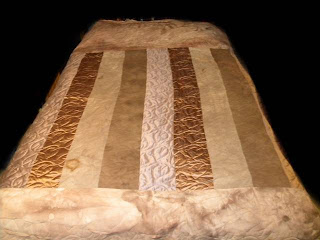I made this fun quilt quite a few years back, and it won an award in the Cherokee National Holiday Quilt Show. You can see that some of the fabrics are satin. Satin is not a dyer's cloth because it doesn't absorb and hold color without being shocked. Um, that means "runined." So look at the shiny strips-- those are the commercial satin. The flat strips are hand dyed with walnut hulls. The cool thing about walnuts, you already know if you've ever picked up big dog food sized bags of them in the fall--- they stain. On a nice Autumn day when Kanny and Kaleb were little, our Saturday fun was to station a drum and wheelbarrow in the yard, and practice throwing walnuts into the barrel from wherever we found them in the yard. (It soon became apparent that walnuts may go IN to a wheelbarrow, but if so they'll probably knock out at least as many or more walnuts in doing so.) So there we were at the end of the day, with brown stained hands that nothing could clean except time.
Later in the winter a pickle barrel full of walnuts was sitting under the eave and got filled with rainwater. THAT is a stinky mess. I took a bunch of recycled sheets and jammed them down in the water, covering with a lid, and let them soak till Spring. I didn't use any mordant or fixer, and I didn't precondition them with alum or anything. In fact, they had been washed with soap on multiple occasions and were plain white sheets.
I was delighted when I pulled them out and saw the subtle shading. Some places were foxed from being at water level. Some places were paler or darker. Even some sheets took the color better than others. It is amazing to get disparate results like on these strips when using basically the same technique, right down to putting them in the same dyepot. We can guess that there may have been a difference in the cotton content, with some sheets having more synthetic fibers... although I thought they were all cotton. Even bleaching in a former life may have influenced the color variance. The circle and the color "clouds" are all things that showed up in the natural dyeing process.
A cool thing about walnut dyeing is that walnuts are plentiful--- you just use the hulls and all. And it can be done long and slow without a rigorous process. Or it can be done quickly over a boil with stirring for more of a vat-dyed outcome (even coloration). I suspect that temperature influences color intensity, as do the amount of water mixed with the hulls and the age of the hulls. Green hulls would give a silvery champagne tone and oozy black hulls would give darker tones. Basket reed dyers will attest to the fact that different natural fibers, whether it be fabric or reed, wood or wool, will take the dye differently. Some fibers such as silk will be hard to color without using some technique to grab and bite the color. Silk is just hard to dye sometimes.
I think this quilt was commercially quilted by Wavalene at Living Designs in Tahlequah and it is probably lo-loft batted with a pantogram design perhaps that Wavalene has created.
I was experimenting with pintucking when I worked on this quilt. I had seen a beautiful dress of Rachel Martin in a Cherokee art book. I think it is in a museum in Tennessee. Rachel Martin was a distant relative and of a notable Cherokee family in history, and her spectacular dress had a lot of pintucking and pleats. Here's a detail view showing the informal pintucking on the header and footer borders of this quilt:
Doesn't the marbling from walnut dye and the funky pintucking make for an elegant and complex visual experience? This quilt is sort of plain but it has interesting visual and tactile textures.






No comments:
Post a Comment